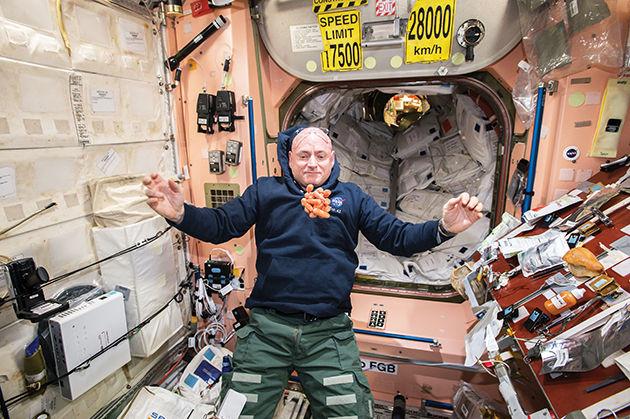Spending time in zero gravity causes extreme stress on the human body — a phenomenon that astronaut Scott Kelly’s return from space will shed light on.
NASA astronaut Scott Kelly — along with Russian cosmonaut Mikhail Kornienko — comes back home Tuesday from a 340-day International Space Station mission, now holding the U.S. record with a total of 520 days in space. Scott Kelly’s return will offer the medical community the rare opportunity to analyze the differences between Scott Kelly, who has lived in zero gravity nearing a year with his twin, former astronaut Mark Kelly, who has been living on Earth, to better understand the effects of long-duration spaceflight on the human body.
David Hyland, aerospace engineering professor, said this unusually prolonged mission and rare case-study will help determine effects on the human body’s reaction to extraterrestrial environments.
“After a long duration like this, it allows us to study the physiological and psychological effects in space or zero-g on the human body,” Hyland said. “No human has ever traveled in interplanetary space, and after about 5 decades of space flight, we still don’t know how much g [experienced gravity] is required to keep humans healthy.”
When an astronaut enters space, their bodies adapt to the zero-g environment. In Kelly’s case, his mission was twice the length of normal missions so the effects on his body from living with no gravity will be more severe. Hyland said the longer the duration, the more an individual’s muscular, cardiovascular and respiratory system diminishes — causing a loss of fluids into the extremities.
“There are vision problems, irregular heart beat, changes of electrical activity, bone loss and atrophy of all muscles,” Hyland said. “Essentially Scott Kelly has contributed his bodily welfare to a long term study of the effects of zero-g and radiation exposure and that was the main purpose of the mission.”
Exercise is very important for astronauts to prepare for their descent back to earth and restore their bone and muscular strength. Bonnie Dunbar, aerospace engineering professor and retired U.S. astronaut, said there are ways to prepare for the health and all other complications, but a zero-gravity environment cannot be fully recreated on Earth.
“There’s no such thing as a general gravity room anywhere on the surface of the Earth,” Dunbar said. “It is not a force or acceleration we can turn on and off with a switch — we have to find analogs for it. We started very early on with people looking at 20 seconds at a time in a parabolic aircraft, but that’s not a long duration.”
Putting humans in a weightless environment for an extended period of time is the long-term goal of NASA. Dunbar said this experiment offers great opportunity, because the people being compared have the same genetics.
“What you’re seeing is the gradual length of the on [orbit-time], so we can better understand the effects of the human body before we send them to a round-trip to Mars and back,” Dunbar said. “We know so many of our biomedical responses are not due to environment; they are genetic. Some people are a little more genetically predisposed to [bone loss]. In this case, you have a one-to-one control where two people have very similar genetics.”
John Charles, chief scientist of NASA’s Human Research Program, said in a NASA article that the mission will continue after Scott Kelly’s return to Earth.
“We will be collecting post-flight medical data three-months and six-months after he is back on Earth,” Charles said. “For the twins study research, we will continue to collect data as far out as a year after his return. The post-flight data are as important as the inflight data to help us learn how to send humans safely to Mars and return them safely to Earth.”
Determining the length of a Mars mission and the effects of low-gravity environments in space travel or on other planets is difficult to estimate given the amount of time it would take to complete a mission like that.
“We don’t have many choices when it comes to getting to Mars,” Dunbar said. “We are governed by the laws or orbital mechanics and the position of the planets. So we have designed reference missions, many different paths to get there. There is a launch window that happens every 26 months that has a minimum transit time of typically 6 months. But you have to wait for the planets to align for the return, so they may be on the surface for over a year.”
Dunbar said they have much more to invent and design before another human space mission.
“We really want to grow research on human systems,” Dunbar said. “It’s important we understand what happens to the human body but we also have a number of designed engineering problems left to solve and we need young people to help us solve it.”
US astronaut and twin assist in zero-g research
March 1, 2016
Donate to The Battalion
Your donation will support the student journalists of Texas A&M University - College Station. Your contribution will allow us to purchase equipment and cover our annual website hosting costs.























